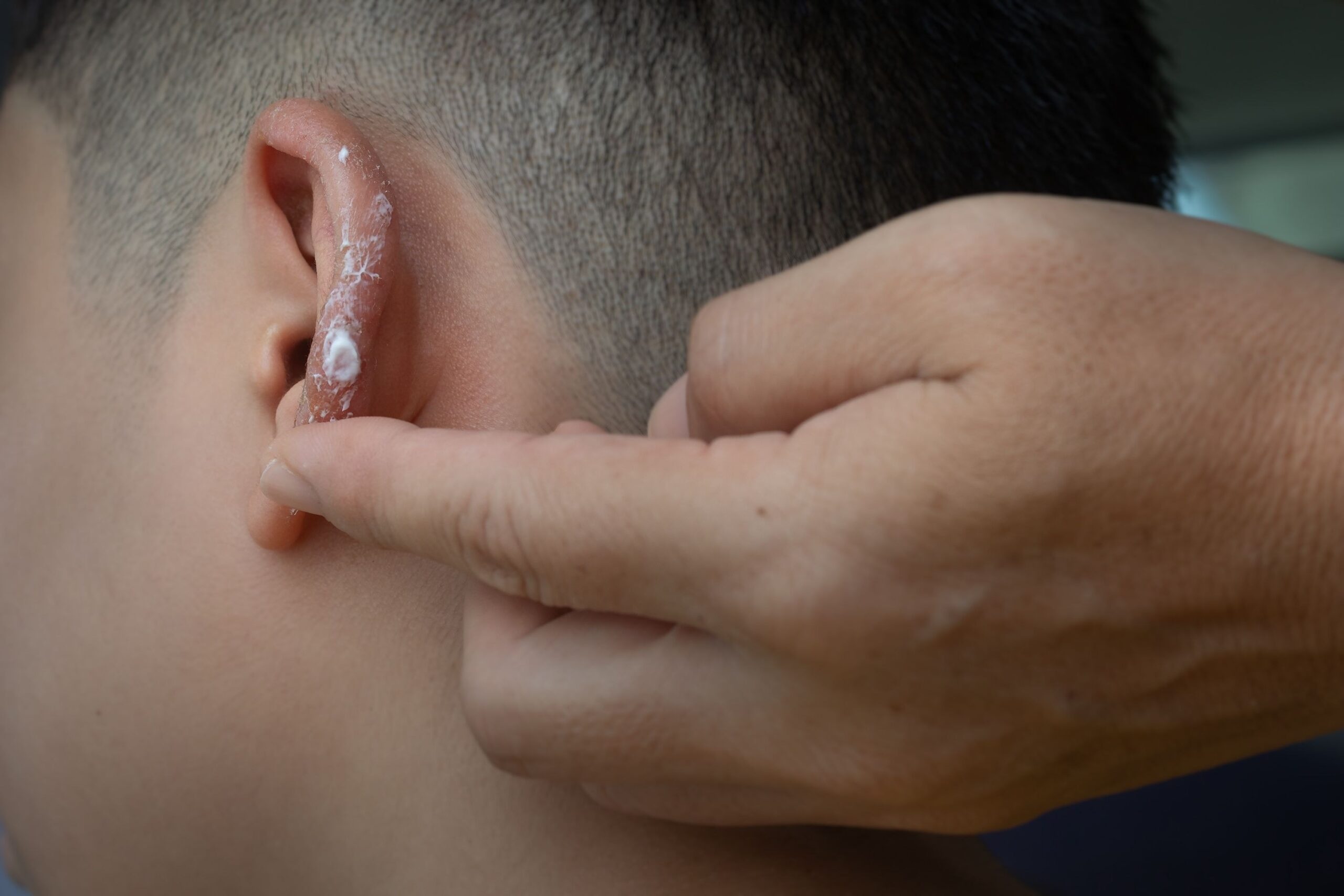Choosing the Right Antibiotic for Ear Infection: Treatment & Tips


If an ear infection is giving you trouble, you may wonder whether you need an antibiotic for an ear infection. Our focused guide dives into which antibiotics work best for ear infections, the right time to use them, and other treatments if antibiotics aren’t suitable.
Key Takeaways
Antibiotics are frequently used to treat ear infections, but their necessity depends on the patient’s age, severity, and response time to infection.
Many antibiotics are appropriate for treating ear infections, with amoxicillin being the first choice, but alternatives exist for those with allergies or resistant infections.
While antibiotics can be effective, they aren’t always necessary, and misuse can lead to resistance; patients should explore alternative treatments, prioritize prevention strategies, and seek medical advice when symptoms are serious.
Understanding Antibiotics and Their Role in Treating Ear Infections
Infections of the ear, including acute otitis media and otitis externa, frequently encounter conditions that result in considerable discomfort and pain. Signs of these infections may include a reddened and swollen eardrum, discharge from the outer ear canal, and elevated body temperature. Specifically speaking about acute otitis media, this condition manifests with infected fluid accumulation and inflammation within the middle ear. Individuals suffering from it often experience symptoms such as pain in the ear, fluid drainage leading to hearing difficulty or temporary hearing loss, along with potential balance problems — particularly prevalent among children due to factors like respiratory ailments they’re recovering from allergies they might have or even their environmental exposure to substances like tobacco smoke.
Antibiotics are commonly prescribed as treatment options for infections plaguing ears. Discerning when they should actually be utilized is crucial. These medications can serve quite effectively but aren’t invariably appropriate in every case involving an infection of this nature—hence why delving deeper into understanding their proper application remains important.
When Are Antibiotics Necessary?
The administration of antibiotics for ear infections is contingent upon various criteria. Infants under the age of six months diagnosed with acute otitis media are commonly prescribed antibiotics immediately to circumvent waiting to determine if the infection will resolve independently due to their susceptibility to potential complications associated with the infection. Antibiotic treatment may also be recommended for children younger than two years exhibiting symptoms in both ears.
In circumstances where children:
have reached a minimum age of six months
experience moderate to severe pain in the ear that persists for at least 48 hours
display a fever reaching or exceeding 102.2°F
show no signs of improvement from an ear infection after three days’ duration
exhibit discharge stemming from within the ear
possess a compromised immune system that elevates their risk for additional health issues
Antibiotics could be deemed necessary as part of their medical care.
Recognizing that prescribing antibiotics for treating ear infections isn’t always standard practice is critical. Many infections tend toward spontaneous resolution without significantly impacting symptomatic concerns like ear discomfort. Consequently, these medications might not be indispensable when addressing certain ear-related ailments.
Selecting an Appropriate Antibiotic
When antibiotics are needed for ear infections, selecting the appropriate one is essential. For middle ear infections in adults and children, amoxicillin is the top choice, whereas adults with acute otitis media frequently receive amoxicillin-clavulanate as an initial treatment option.
If the patient has recently used amoxicillin, if there is a presence of purulent conjunctivitis or non-severe penicillin allergies, alternative antibiotics are considered. Children who exhibit mild allergic responses to penicillins may be treated with cefprozil or cefuroxime. Similarly, adult patients allergic to penicillins might find relief using antibiotic treatments such as cefdinir, cefpodoxime, or azithromycin for their ear infections.
Potential Side Effects of Antibiotic Use
Using antibiotics can be beneficial, but it’s crucial to consider the negative consequences they may bring. Antibiotics used too often may lead to bacteria developing resistance, complicating future bacterial infection treatments. Adherence to the prescribed course and dosage is vital to avoid this issue. Typically, treatment of acute otitis media with antibiotics spans five to ten days, based on the severity of the infection.
Should you forget to take a dose of your antibiotic medication for otitis media, it is recommended that you seek guidance from your healthcare provider or pharmacist. Responsible use of antibiotics aids not only in your own recovery but also serves a broader purpose by helping fight antibiotic resistance globally.
The Efficacy of Antibiotics Against Middle Ear Infections

Treatment with antibiotics can be quite effective for middle ear infections, although this is not always the case. Antibiotics are not prescribed for inner ear infections that tend to clear up themselves. These medications have a limited function in reducing symptoms like pain associated with such conditions. Hence, if there’s no sign of recovery from a middle ear infection within 48 to 72 hours, seeking advice from a healthcare provider is advisable.
Ignoring treatment for a middle-ear infection may result in serious complications, including the spread of the infection to nearby areas, lasting hearing loss, or possibly paralysis of facial nerves. Should chronic cases of middle-ear infections arise, they might necessitate Assessment by an expert and potentially advanced diagnostic procedures such as CT scans or MRI to identify an accurate course of action for treatment.
Treatment Success Rates
Most adults suffering from acute otitis media experience considerable improvement within 48 to 72 hours of commencing the correct antibiotic therapy. The efficacy of this treatment is contingent upon the specific type of antibiotic prescribed. For example, amoxicillin-clavulanate has been demonstrated to resolve middle ear infections at an impressive rate of 86.5%, markedly surpassing cefdinir’s cure rate, which stands at 71%.
These findings highlight the importance of choosing an appropriate antibiotic when treating such infections. Effective management goes beyond merely using any antibiotic and hinges on selecting one optimally suited for combating the particular strain causing the disease in the middle ear.
Addressing Recurrent Otitis Media
Managing recurrent ear infections, or otitis media, can be pretty tricky. For those experiencing repeated episodes of these infections in the middle ear, particularly children with chronic cases, inserting tympanostomy tubes into the eardrum may be advised. These small cylinders ventilate the middle ear and prevent fluid build-up.
It is vital to monitor children who have frequent ear infections or continuous fluid in their middle ears closely, as this condition could indicate a need for interventions like earmarking them for tympanostomy tube insertion. Likewise, adults suffering from multiple bouts of acute otitis media should undergo assessments for abnormalities in their eustachian tubes or nasopharyngeal regions that might contribute to recurring infections.
Alternative Treatments and Home Remedies for Ear Pain Relief

When antibiotics are not the answer, alternative treatments and home remedies can help manage ear pain and other symptoms. Drinking plenty of fluids and getting adequate rest are natural remedies that can help manage the symptoms of an ear infection. If antibiotics are not prescribed due to factors like a child’s age or mild symptoms, eardrops containing a painkiller and an anesthetic could be a possible alternative treatment.
Warm compresses or over-the-counter pain relievers may be advised for immediate pain relief from an acute ear infection. These approaches can relieve and help manage symptoms while your body fights the infection. To treat ear infections effectively, it is essential to consult with a healthcare professional for proper diagnosis and treatment options.
Home Care Tactics
It’s important to effectively manage ear pain at home since antibiotics are not always immediately dispensed due to the self-resolving nature of many ear infections. A warm or cool compress on the affected ear can help ease discomfort. Experiment with both temperatures to determine which one brings greater relief. A heating pad on a low setting can be an effective method for soothing earache.
Maintaining an upright posture while resting may facilitate fluid drainage from the middle ear, lessening pressure and reducing pain associated with the infection. Employing these straightforward strategies could significantly mitigate discomfort during an episode of an ear infection.
Over-the-Counter Solutions
OTC remedies can significantly alleviate symptoms tied to ear infections, providing comfort as one observes whether the infection resolves spontaneously. Oral pain relievers such as acetaminophen and ibuprofen, available over the counter, can help reduce discomfort caused by these infections.
However, caution is advised since specific OTC options should not be used. Specifically, decongestants and antihistamines have been advised against symptom management in ear infections. It’s crucial to scrutinize product labels meticulously and seek advice from a healthcare provider when uncertainty arises regarding appropriate treatment measures.
Prevention Strategies to Reduce the Risk of Ear Infections

Beyond treatment, it’s important to consider how to prevent ear infections in the first place. Flu vaccinations can lower the risk of flu-related ear infections, and practicing cold prevention measures and avoiding contact with sick individuals can be beneficial strategies.
To prevent ear infections, it is essential to:
Avoid environmental irritants, particularly cigarette smoke and pollution, as they can cause inflammation.
Keep ears clean and dry.
Avoid using cotton swabs deep in the ear canal.
Following these steps can help reduce the risk of repeat ear infections.
Daily nasal irrigation with saline may help prevent ear infections by keeping the Eustachian tube free of irritants and allergens.
Vaccinations and Hygiene
Immunizations are critical in the battle against ear infections. Specifically, the conjugate pneumococcal vaccine effectively guards against bacteria responsible for many ear infections. Influenza shots reduce the likelihood of acquiring flu-related complications, resulting in subsequent ear ailments.
Maintaining good personal hygiene is equally important in preventing ear infections. Consistently washing one’s hands is an essential practice that significantly diminishes the risk associated with these types of bacterial invasions into the ear.
Lifestyle Adjustments
Certain lifestyle changes, hygiene, and vaccinations are crucial to significantly lowering the likelihood of incurring multiple ear infections. Environmental irritants such as pollution and secondhand smoke, which can trigger inflammation within the ear and result in an infection, should be avoided.
Knowing When to Consult a Healthcare Provider
Even with preventative measures, ear infections can arise. It is essential to know when medical intervention is necessary. When an individual experiences symptoms such as ear pain, discharge from the ears, dizziness, ringing in the ears (tinnitus), a feeling of fullness in the ear, hearing loss, or facial weakness, they should seek advice from a healthcare provider.
Adults who develop ear infections should pay special attention and promptly address these conditions. They might signal underlying serious health problems that need a professional assessment. Correctly identifying acute otitis media among adults requires careful examination by a healthcare provider through clinical evaluation and an otoscope.
Recognizing Serious Symptoms
If you encounter specific symptoms, getting medical attention promptly is critical. These symptoms include:
Elevated fever
Intense pain at the back of your ear
Facial paralysis
Acute pain in the ear
Sudden release of yellow or green fluid from the ear
Suppose you notice additional worrying signs, such as swelling behind your ear and a deteriorating condition despite receiving treatment. In that case, if there is the onset of new issues like severe headaches or facial muscle cramps and continued hearing loss after an infection in the area has occurred, you should immediately seek advice from a healthcare provider. Professional consultation becomes even more pressing if an infection within your auditory region comes with extreme dizziness that persists, constant high fevers, or noticeable deterioration in hearing capabilities.
The Importance of Medical Evaluation
Immediate medical assessment is crucial for correctly diagnosing ear infections and spotting any severe complications that might arise. Babies younger than six months exhibiting symptoms of an ear infection require swift medical care to decide whether treatment is necessary.
An exhaustive medical examination is vital in correctly diagnosing ear infections and detecting any grave complications that may impact the auditory system or adjacent areas within the skull. Early medical intervention can enhance recovery prospects and avert lasting adverse effects associated with these infections.
How NiHowdy’s Prescription Discount Card Can Benefit You
Utilizing NiHowdy’s prescription discount card can be an effective strategy for controlling healthcare expenses. The card’s purpose is to minimize the personal cost burden for medication, offering substantial reductions that could reduce the price tag on costly brand-name prescriptions to a mere $5 monthly.
With its coverage extending over numerous medications, encompassing generic and brand-name options, NiHowdy’s discount card is particularly advantageous for individuals without insurance or those grappling with hefty deductibles and copays. It sweetens the deal by providing up to 3% cashback in Bitcoin with each prescription transaction made using the card.
Immediate Savings on Prescriptions
NiHowdy’s prescription discount cards are structured to reduce patients’ immediate expenses when buying medications. These copay cards deliver on-the-spot discounts during purchase, covering all or part of a patient’s required copayment or coinsurance.
By utilizing these prescription discount cards at the time of the transaction, individuals can save as much as 85% on their prescriptions. It should be noted that savings may differ based on which pharmacy is visited and the particular discount card chosen. This enables prompt financial ease for consumers, easing some strain in managing healthcare costs.
Long-Term Financial Gains
While immediate savings are helpful, the long-term financial benefits of NiHowdy’s card should not be overlooked. Even with the maximum savings limit imposed on copay cards per month or year, NiHowdy’s card aims to provide financial relief for antibiotic purchases that can result in long-term user savings.
Users need to be aware of these limits when planning their healthcare budget to maximize their benefits over time. Despite these limits, the strategic use of NiHowdy’s card can still contribute significantly to long-term healthcare cost savings. The returns from NiHowdy’s prescription discount card are accelerating in value and can help offset rising healthcare costs and other major life expenditures.
Summary
Navigating the world of ear infections can be complex, but it’s manageable with the right knowledge and resources. Understanding when to use antibiotics, exploring alternative treatments, knowing when to seek medical attention, and implementing prevention strategies are crucial. Add to this the financial benefits of NiHowdy’s prescription discount card, and you’re well-equipped to handle ear infections head-on. Remember, an informed patient is an empowered patient.
Frequently Asked Questions
When are antibiotics necessary for an ear infection?
For infants younger than six months and children under two years with an infection in both ears, antibiotics are required to treat an ear infection. This is also true if moderate to severe pain in the ear persists for a minimum of two days or if there’s a high fever.
What are alternative treatments for ear infections?
Alternative treatments for ear infections include anesthetic and painkilling eardrops, over-the-counter pain medications, and home remedies such as applying warm compresses. These can alleviate symptoms when antibiotics are not deemed necessary.
How can I prevent ear infections?
To reduce the likelihood of developing ear infections, it’s advisable to receive flu shots, avoid unwell people, avoid irritants in your environment, maintain clean and dry ears, and consistently practice good hand hygiene.
Adhering to these measures can diminish the chances of contracting ear infections.
What symptoms require immediate medical attention?
Should you suffer from intense ear pain, a high fever, severe discomfort behind the ear, facial paralysis, or an abrupt release of yellow or green fluid from the ear, it is crucial to promptly seek medical care to manage these critical symptoms.
How can NiHowdy’s prescription discount card benefit me?
The prescription discount card from NiHowdy can lead to instant and enduring reductions in the cost of patented medications and generic drugs, aiding in controlling healthcare expenses.


